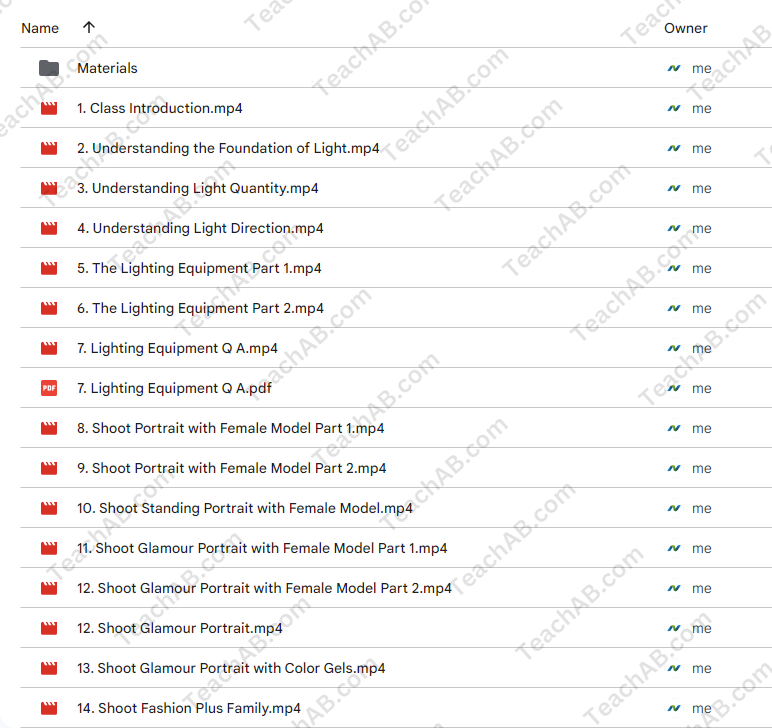Studio Lighting Basics By Tony Corbell
$24.00 $5.00
Studio Lighting Basics By Tony Corbell – Digital Download!
Content Proof:
Exploring the Foundations of Studio Lighting: Insights from Tony Corbell
Studio lighting can be likened to the soul of photography without it, images tend to fall flat, devoid of their intended expression and emotional depth. In his illuminating book, Studio Lighting Basics, photographer and educator Tony Corbell offers a robust framework for understanding and mastering lighting techniques that can make or break a photograph. With his years of teaching experience and a wealth of practical knowledge, Corbell presents a guide aimed primarily at beginners. However, the profound insights and actionable tips provided within its pages extend well into the territory of seasoned professionals, making this work a cornerstone resource for anyone serious about improving their studio lighting skills.
Whether you are capturing the pristine contours of a still life or the lively gestures of a portrait, the effective use of light can transform an ordinary setting into a compelling visual narrative. Corbell emphasizes the fundamental importance of not just mastering the equipment, but also grasping the underlying theories of light principles that govern how light interacts with different surfaces and how various setups can evoke different responses in your subjects. The book is structured in a way that allows readers to incrementally build their understanding, starting from the basics and gradually progressing towards more complex concepts.
The Importance of Understanding Lighting Equipment
When embarking on the journey of mastering studio lighting, familiarity with lighting equipment is non-negotiable. Corbell elaborates on several types of lighting gear, discussing the merits and ideal applications for each piece. The offerings range from softboxes to reflectors, umbrella lights to LED panels. Each has its unique characteristics, and understanding them can create a substantial impact on the final output of your photography.
Types of Lighting Equipment:
- Softboxes:
- Diffuse light to reduce shadows.
- Create a softer and more even illumination, ideal for portraits.
- Umbrella Lights:
- Lightweight and versatile.
- Can reflect or transmit light, depending on the setup.
- LED Panels:
- Energy-efficient with adjustable color temperatures.
- Allow for more creative control with consistent output.
Each of these tools serves not just as a source of illumination, but as a canvas upon which the photographer paints with light. Corbell’s exploration helps demystify them, providing practical advice that aligns with his pragmatic approach to teaching.
The Art and Science of Light Theory
Understanding light theory can transform the way photographers perceive and utilize their surroundings. Corbell takes readers through fundamental concepts such as the color temperature of light and its impact on mood, and introduces the idea of exposure settings, which dictate how images are captured.
Key Concepts in Light Theory:
- Color Temperature:
- Measured in Kelvin (K), this describes the warmth or coolness of light.
- Daylight is approximately 5600K, while tungsten lights can range around 3200K.
- Exposure Settings:
- ISO, aperture, and shutter speed interplay to control the amount of light reaching the camera sensor.
- Understanding the exposure triangle is crucial for achieving the desired artistic effect.
- Lighting Ratios:
- The balance of light and shadow produced by multiple light sources.
- Importantly influences the depth and drama of the final image.
Through these discussions, Corbell emphasizes that grasping the science behind light can lead to much more than simply taking pretty pictures it allows photographers to communicate stories and evoke emotions through their work.
Combining Studio and Natural Light: A Practical Approach
One of the standout elements of Corbell’s book is the focus on blending studio and natural light. Photographers often find themselves in situations where they must rely on ambient light alongside artificial setups, and knowing how to harmonize the two can yield striking results.
Techniques for Combining Lights:
- Balance Exposure:
- Ensuring that the exposure levels between the studio lights and natural light sources complement rather than compete with each other.
- Color Matching:
- Adjusting the color temperature settings of studio lights to match the ambient light, thereby ensuring a cohesive look.
- Shadow Control:
- Designing setups that allow natural light to fill in shadows created by artificial sources, providing a dimensional quality to portraits.
Corbell illustrates these techniques with vivid examples and visual aids, making it possible for readers to see his recommendations brought to life. Just as a painter mixes colors to achieve the perfect hue, photographers must learn to blend various light sources to create depth and interest in their images.
The Role of Backgrounds in Lighting Outcomes
Another essential aspect Corbell explores is the impact of various backgrounds on lighting effects. The backdrop can serve not just as a support for the subject but as an integral element that influences how light interacts with the entire scene.
Types of Backgrounds and Their Effects:
- Seamless Paper:
- Provides a clean and professional look.
- Reflects light evenly, making it a popular choice for commercial photography.
- Textured Surfaces:
- Add depth and interest to images.
- Can create unique shadows and highlight interactions.
- Natural Environments:
- Incorporates elements that respond dynamically to changing light conditions.
- Offers an organic feel that resonates well in portrait photography.
By evaluating how different backgrounds react with light, photographers can make informed decisions that enhance the overall quality of their compositions. Corbell offers actionable tips and visual references that clarify the practical applications of these principles.
Visual Aids and Illustrative Examples
The inclusion of visual aids in Studio Lighting Basics is worth mentioning, as these elements significantly enhance the learning experience. Corbell employs a variety of diagrams and annotated images to help readers visualize complex concepts, making the learning process both engaging and intuitive.
Benefits of Visual Learning:
- Enhanced Understanding:
- Visual aids can simplify intricate theories, making them easier to digest.
- Real-Life Applications:
- Examples of various setups show how principles translate to practice.
- Increased Retention:
- Well-illustrated content facilitates better memory retention for learners.
By creating a vibrant interplay between text and visuals, Corbell enriches the material, which helps bridge the gap between theory and practical application.
Conclusion
In the realm of photography, light is not merely a technical element it’s the very fabric that shapes each image’s narrative and emotional resonance. Tony Corbell’s Studio Lighting Basics serves as a vital resource that empowers photographers to take control of their creative expression through light. By integrating a deep understanding of both the technical and artistic aspects of lighting, readers can elevate their artistry to new heights.
Through a thoughtful blend of theory, practical advice, and illustrative examples, Corbell makes the complex world of studio lighting both accessible and engaging. His passion for teaching is embodied in the book, inspiring countless photographers to delve deeper into the enchanting world of light. Whether you’re just starting or looking to refine your skills further, this guide will undoubtedly enhance your journey in studio photography, helping to unlock the full potential of your creative vision.
Frequently Asked Questions:
Business Model Innovation: We use a group buying approach that enables users to split expenses and get discounted access to well-liked courses.
Despite worries regarding distribution strategies from content creators, this strategy helps people with low incomes.
Legal Aspects to Take into Account: Our operations’ legality entails several intricate considerations.
There are no explicit resale restrictions mentioned at the time of purchase, even though we do not have the course developers’ express consent to redistribute their content.
This uncertainty gives us the chance to offer reasonably priced instructional materials.
Quality Assurance: We guarantee that every course resource you buy is exactly the same as what the authors themselves are offering.
It’s crucial to realize, nevertheless, that we are not authorized suppliers. Therefore, the following are not included in our offerings:
– Live coaching sessions or calls with the course author.
– Entry to groups or portals that are only available to authors.
– Participation in closed forums.
– Straightforward email assistance from the writer or their group.
Our goal is to lower the barrier to education by providing these courses on our own, without the official channels’ premium services. We value your comprehension of our distinct methodology.
Be the first to review “Studio Lighting Basics By Tony Corbell” Cancel reply
You must be logged in to post a review.
Related products
Photography & Art
DRAMATIC PORTRAITURE LIGHTING STYLING AND RETOUCHING by CHRIS KNIGHT
Photography & Art
Ancient English Forest Composite Stock Assets by Clinton Lofthouse
Photography & Art
Photography & Art
Photography & Art
Photography & Art
Digital Marketing for Your Photography Business by Jared Bauman



















Reviews
There are no reviews yet.